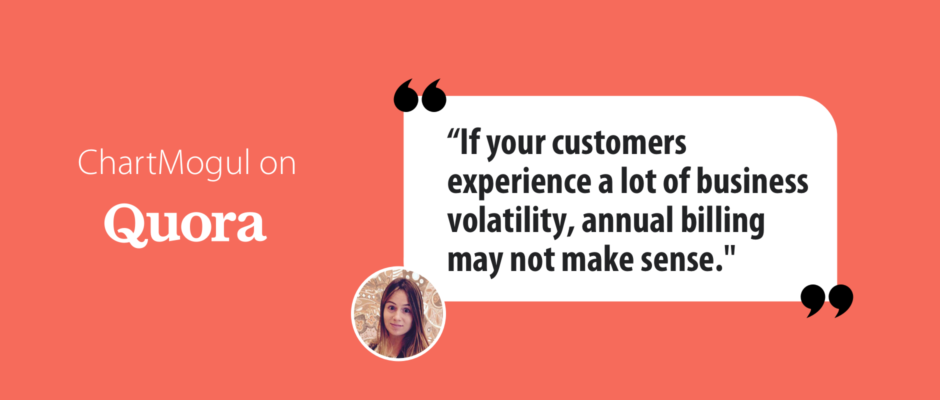Last week we reviewed how annual billing impacts a subscription business. The benefits seem all-around convincing, so this week we thought we’d explore the other side of the issue.
Given that SaaS giants like Salesforce, Zendesk, and Intercom all charge month to month, what are the reasons a SaaS company wouldn’t use annual billing?
Here are two general reasons why a SaaS company might not want to use annual billing. The first has to do with the company’s SaaS pricing model, and the second has to do with customer engagement and SaaS metrics.
More flexible pricing
One key reason a SaaS company would not want to use annual contracting is if they price their product based on some kind of volume variant, such as number of licenses or users.
The volume is divided into bands (0<100, 101<200, 201<300). Each band is a different tier of pricing — and usually marketed as a different plan. On a certain tier, the customer’s use of the service could max out at a specific limit, at which point they would need to upgrade to the next plan.
The potential conflict between this type of pricing model and annual contracting is that your customers’ demand for, or use of, your SaaS product might fluctuate over the course of 12 months. The customer could bounce from one tier to the next, and this could wreak havoc on your internal bookkeeping, accounting, operations, etc.
For example: If a customer downgrades to a cheaper plan at month 4, but has already paid upfront for a year-long contract, do you then have to process an 8-month refund for the difference? And what if they have a great quarter and then want to re-upgrade in month 9?
Essentially, if your pricing model leaves room for mobility through the different tiers, or if your customers experience a lot of business volatility, annual billing doesn’t really make sense. Let’s look at some of this type of pricing model.
User-based pricing
This is a pricing model based on “the number of seats” or users that your customer has using your product on their end. This pricing model is in some very notable places, such as Salesforce and Zendesk.
API-based SaaS
API-based products design their pricing differently as well. Some, like Clearbit, have pricing tiers based on number of requests made to their API, whereas others may be based on the volume of data transmitted.
Moreover, some APIs could charge not by tiered bandwidth or monthly contract at all, but charge more transactionally and on a granular level — individually per call (or per request) made to their API. In this way, the billing for a SaaS product breaks away from the typical recurring revenue structure of SaaS.
Accurate insight into customer success and SaaS metrics
This reason is less technical, and actually a bit more personal to the business management style of the founder or executive team. When customers are committed to an annual contract, it locks in a large proportion of your revenue and therefore also stabilizes your performance metrics (MRR, Churn, and so on).
Month-to-month billing involves a lot of interaction between your company and customer, ensuring their satisfaction and keeping them on board. As a result you have your fingers on the pulse of your customer base, how they use and perceive your product. You also know that your metrics reflect a real-time performance of your business.
With the reduced interaction that could come with an annual contract, there’s a risk you lose touch with how engaged and satisfied your customers are. And the healthy SaaS metrics you see, buoyed by annually-contracted revenue, can’t reflect any risks in real time either. Of course, there are safeguards and processes to put in place to ensure your team stays on top of this.
Final word
At ChartMogul we followed in Intercom’s footsteps to move away from annual contracts, for the reasons above. We pursued “value-based pricing.” That said, there are plenty of reasons for SaaS companies to pursue annual contracts, and those are worth hearing, too. Here’s a short answer about why some SaaS prefers annual billing and how it impacts a subscription business.
And if you’re curious about other things to do with SaaS pricing, check out these 5 key learnings from analyzing top B2B SaaS pricing pages.
